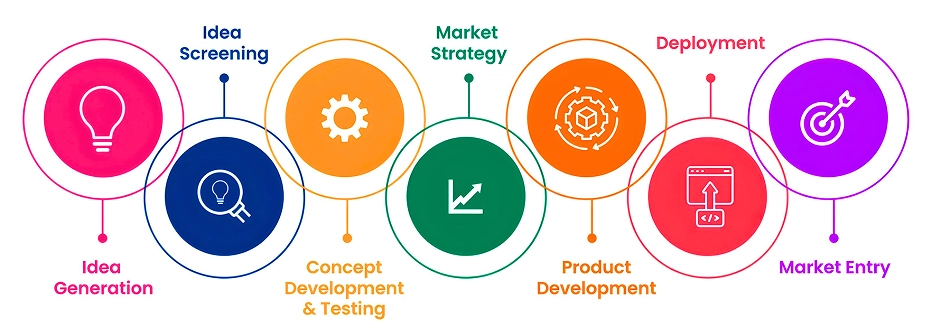Mastering Product Development: From Concept to Market Success
Bringing a new product to market is a complex journey that requires strategic planning, cross-functional collaboration, and a deep understanding of customer needs. This guide outlines the key stages of product development and offers best practices to ensure your product's success.

1. Key Stages of Product Development
Idea Generation
Innovation begins with generating ideas, which can stem from customer feedback, market research, or internal brainstorming sessions. Encouraging a culture of creativity and open communication can lead to valuable insights and innovative concepts.
Concept Development
Once ideas are generated, they need to be developed into viable product concepts. This involves defining the product's features, benefits, and target audience. Concept testing with potential customers can provide early feedback and help refine the product vision.
Business Analysis
Before moving forward, it's crucial to assess the market potential and financial viability of the product. Conducting thorough market research, competitive analysis, and cost projections ensures that the product aligns with business goals and customer needs.
Design and Development
In this stage, the product takes shape through detailed design and development processes. Creating prototypes and iterating based on testing results helps in refining the product and addressing any technical challenges.
Testing and Validation
Rigorous testing is essential to ensure the product meets quality standards and customer expectations. This includes alpha and beta testing, usability testing, and performance evaluations to identify and fix any issues before launch.
Commercialization
Launching the product involves developing marketing strategies, preparing promotional materials, and establishing distribution channels. A successful launch requires coordination across various departments to ensure the product reaches the target market effectively.
Post-Launch Review
After the product is in the market, continuous monitoring of its performance is necessary. Gathering customer feedback, analyzing sales data, and making necessary adjustments help in improving the product and informing future development efforts.

2. The Importance of Cross-Functional Collaboration
Effective product development relies on the collaboration of diverse teams, including R&D, marketing, sales, finance, and customer service. Cross-functional teams bring varied perspectives and expertise, leading to more innovative solutions and efficient problem-solving. Regular communication and shared goals are key to successful collaboration.
3. Best Practices for Successful Product Development
- Customer-Centric Approach: Prioritize understanding customer needs and preferences through user research and empathy mapping.
- Robust Planning: Develop clear roadmaps with defined timelines, milestones, and responsibilities to guide the development process.
- Effective Communication: Maintain transparency and open lines of communication among all stakeholders to facilitate feedback and alignment.
- Quality Assurance: Implement rigorous testing protocols and embrace continuous improvement to enhance product quality and customer satisfaction.

Case Studies and Examples
- Tech Startup: A startup leveraged customer feedback during development, leading to iterative improvements and a successful product launch.
- Large Corporation: A multinational company overcame development challenges by fostering cross-functional collaboration, resulting in a product that met market demands and achieved commercial success.
Conclusion
Mastering product development requires a structured approach, collaborative efforts, and a focus on delivering value to customers. By following these stages and best practices, businesses can navigate the complexities of product development and achieve market success.
Supercharge Your IT & Workforce Strategy
Ready to Transform Your Industry?
No matter your industry, we’re here to help you drive innovation and improve your business operations. Let’s discuss how our tailored IT solutions can help your business succeed.